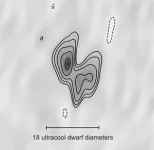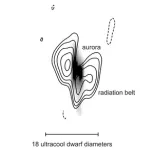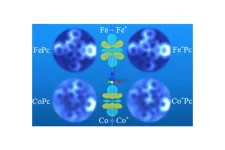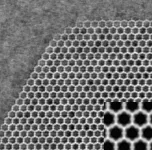(Press-News.org) New synthetic metabolic pathways for fixation of carbon dioxide could not only help to reduce the carbon dioxide content of the atmosphere, but also replace conventional chemical manufacturing processes for pharmaceuticals and active ingredients with carbon-neutral, biological processes. A new study demonstrates a process that can turn carbon dioxide into a valuable material for the biochemical industry via formic acid.
In view of rising greenhouse gas emissions, carbon capture, the sequestration of carbon dioxide from large emission sources, is an urgent issue. In nature, carbon dioxide assimilation has been taking place for millions of years, but its capacity is far from sufficient to compensate man-made emissions.
Researchers led by Tobias Erb at the Max Planck Institute for Terrestrial Microbiology are using nature's toolbox to develop new ways of carbon dioxide fixation. They have now succeeded in developing an artificial metabolic pathway that produces the highly reactive formaldehyde from formic acid, a possible intermediate product of artificial photosynthesis. Formaldehyde could be fed directly into several metabolic pathways to form other valuable substances without any toxic effects. As in the natural process, two primary components are required: Energy and carbon. The former can be provided not only by direct sunlight but also by electricity - for example from solar modules.
Formic acid is a C1 building block
Within the added-value chain, the carbon source is variable. carbon dioxide is not the only option here, all monocarbons (C1 building blocks) come into question: carbon monoxide, formic acid, formaldehyde, methanol and methane. However, almost all of these substances are highly toxic - either to living organisms (carbon monoxide, formaldehyde, methanol) or to the planet (methane as a greenhouse gas). Only formic acid, when neutralised to its base formate, is tolerated by many microorganisms in high concentrations.
"Formic acid is a very promising carbon source," emphasizes Maren Nattermann, first author of the study. "But converting it to formaldehyde in the test tube is quite energy-intensive." This is because the salt of formic acid, formate, cannot be converted easily into formaldehyde. "There's a serious chemical barrier between the two molecules that we have to bridge with biochemical energy - ATP - before we can perform the actual reaction."
The researcher's goal was to find a more economical way. After all, the less energy it takes to feed carbon into metabolism, the more energy remains to drive growth or production. But such a path does not exist in nature. "It takes some creativity to discover so-called promiscuous enzymes with multiple functions," says Tobias Erb. "However, the discovery of candidate enzymes is only the beginning. We're talking about reactions that you can count along with since they're so slow - in some cases, less than one reaction per second per enzyme. Natural reactions can happen a thousand times faster." This is where synthetic biochemistry comes in, says Maren Nattermann: "If you know an enzyme’s structure and mechanism, you know where to intervene. Here, we benefit significantly from the preliminary work of our colleagues in basic research."
High-throughput technology speeds up enzyme optimization
The optimization of the enzymes comprised of several approaches: building blocks were specifically exchanged, and random mutations were generated and selected for capability. "Formate and formaldehyde are both wonderfully suited because they penetrate cell walls. We can put formate into the culture medium of cells that produce our enzymes, and after a few hours convert the formaldehyde produced into a non-toxic yellow dye," explains Maren Nattermann.
The result would not have been possible in such a short time without the use of high-throughput methods. To achieve this, the researchers cooperated with their industrial partner Festo, based in Esslingen, Germany. "After about 4000 variants, we achieved a fourfold improvement in production," says Maren Nattermann. "We have thus created the basis for the model mikrobe Escherichia coli, the microbial workhorse of biotechnology, to grow on formic acid. For now, however, our cells can only produce formaldehyde, not convert it further."
With collaboration partner Sebastian Wenk at the Max Planck Institute of Molecular Plant Physiology, the researchers are currently developing a strain that can take up the intermediates and introduce them into the central metabolism. In parallel, the team is conducting research with a working group at the Max Planck Institute for Chemical Energy Conversion headed by Walter Leitner on the electrochemical conversion of carbon dioxide to formic acid. The long-term goal is an "all-in-one platform" - from carbon dioxide via an electrobiochemical process to products like insulin or biodiesel.
END
With formic acid towards CO2 neutrality
Researchers develop a new method for the sustainable use of carbon dioxide
2023-05-15
ELSE PRESS RELEASES FROM THIS DATE:
Astronomers observe the first radiation belt seen outside of our solar system
2023-05-15
Astronomers have described the first radiation belt observed outside our solar system, using a coordinated array of 39 radio dishes from Hawaii to Germany to obtain high-resolution images. The images of persistent, intense radio emissions from an ultracool dwarf reveal the presence of a cloud of high-energy electrons trapped in the object’s powerful magnetic field, forming a double-lobed structure analogous to radio images of Jupiter’s radiation belts.
“We are actually imaging the magnetosphere of our target by observing the radio-emitting ...
New study reveals widespread presence of environmental DNA in the sky, including allergens and pathogens
2023-05-15
Recently published in PeerJ Life and Environment, researchers successfully use aircraft surveys with novel instrumentation to capture airborne nucleic acids and probe biodiversity in the atmosphere, uncovering surprising findings.
[Clemson, May 2023] - A groundbreaking research article titled "Aircraft Surveys for Air eDNA: Probing Biodiversity in the Sky" unveils a revolutionary approach to studying genetic material in the atmosphere. Scientists have developed a durable and sterilizable probe and supporting system to capture air environmental nucleic acids (eDNA) with full-flow filtration and a high-integrity chamber.
Using this innovative probe, ...
Tetris reveals how people respond to unfair AI
2023-05-15
ITHACA, N.Y. – A Cornell University-led experiment in which two people play a modified version of Tetris revealed that players who get fewer turns perceived the other player as less likable, regardless of whether a person or an algorithm allocated the turns.
Most studies on algorithmic fairness focus on the algorithm or the decision itself, but researchers sought to explore the relationships among the people affected by the decisions.
“We are starting to see a lot of situations in which AI makes decisions on how resources should be distributed among people,” ...
Distinct types of cerebellar neurons control motor and social behaviors
2023-05-15
The cerebellum, a major part of the hindbrain in all vertebrates, is important for motor coordination, language acquisition, and regulating social and emotional behaviors. A study led by Dr. Roy Sillitoe, professor of Pathology and Neuroscience at Baylor College of Medicine and investigator at the Jan and Dan Duncan Neurological Research Institute (Duncan NRI) at Texas Children’s Hospital, shows two distinct types of cerebellar neurons differentially regulate motor and non-motor behaviors during development and in adulthood.
The study, published in Nature Communications, provides the first in ...
Seeing electron orbital signatures
2023-05-15
No one will ever be able to see a purely mathematical construct such as a perfect sphere. But now, scientists using supercomputer simulations and atomic resolution microscopes have imaged the signatures of electron orbitals, which are defined by mathematical equations of quantum mechanics and predict where an atom’s electron is most likely to be.
Scientists at UT Austin, Princeton University, and ExxonMobil have directly observed the signatures of electron orbitals in two different transition-metal atoms, iron (Fe) and cobalt ...
Commercial investors shift perspective of coastal properties in face of climate change
2023-05-15
UNIVERSITY PARK, Pa. — Investors in commercial real estate are rethinking the values of coastal properties exposed to flood risk — even in northern U.S. locales that haven’t suffered flood damage, according to researchers. This shift in perspective has implications for investors and developers alike as they determine the value of coastal properties amid a changing climate.
Eva Steiner, associate professor of real estate and King Family Early Career Professor in Real Estate in the Penn State Smeal College of Business, and her co-authors published these findings recently in Real Estate Economics.
Steiner and ...
Luo to receive NSF funding for collaborative research: catholyte molecular design for non-aqueous mg-organic hybrid redox flow batteries
2023-05-15
Chao Luo, Assistant Professor, Chemistry and Biochemistry, is set to receive funding from the National Science Foundation for the project: "Collaborative Research: Catholyte Molecular Design For Non-Aqueous Mg-Organic Hybrid Redox Flow Batteries."
Luo is proposing a new organic molecule structure design concept for redox flow batteries, which are promising for grid-scale energy storage. The research outcomes will afford low-cost, abundant, sustainable, and high-performance organic catholyte materials for non-aqueous Mg-organic hybrid redox flow batteries.
His goal is to design, synthesize, and characterize core-shell ...
Huneke wins grant to research lesbians in the Third Reich
2023-05-15
Samuel Clowes Huneke, Assistant Professor, History and Art History, has been awarded a Sharon Abramson Research Grant from the Holocaust Educational Foundation of Northwestern University. The award will enable him to complete research for his forthcoming book on lesbians in Nazi Germany.
For many decades after the end of World War II, the fates of queer women were ignored. Because female homosexuality had not been criminalized explicitly, historians long argued that lesbians were not persecuted by the Nazi regime.
In contrast, Huneke’s book, which is under advanced contract with Aevo-University of Toronto Press, argues that queer women under Nazism faced ...
Porous crystals made from plant extracts purify water from pharmaceutical pollutants
2023-05-15
Researchers from Stockholm University have developed porous crystals made from pomegranate extract to capture and degrade pharmaceutical molecules found in local municipal wastewater. The research is published in the scientific journal Nature Water.
Pharmaceutical compounds affect the human body to improve our health, but they can also have unintentional adverse effects for the wellbeing of wildlife. Hence wastewater treatment plants are facing the challenge of removing emerging organic contaminants (EOCs) such as active pharmaceutical ingredients, and therefore ...
Butterfly tree of life reveals an origin in North America
2023-05-15
About 100 million years ago, a group of trendsetting moths started flying during the day rather than at night, taking advantage of nectar-rich flowers that had co-evolved with bees. This single event led to the evolution of all butterflies.
Scientists have known the precise timing of this event since 2019, when a large-scale analysis of DNA discounted an earlier hypothesis that pressure from bats prompted the evolution of butterflies after the extinction of dinosaurs.
Now, scientists have discovered where the first butterflies originated ...
LAST 30 PRESS RELEASES:
The (metabolic) cost of life
CFRI special issue call for papers: New Frontiers in Sustainable Finance
HKU Engineering scholar demonstrates the smallest all-printed infrared photodetectors to date
Precision empowerment for brain "eavesdropping": CAS team develops triple-electrode integrated functional electrode for simultaneous monitoring of neural signals and chemical transmitters during sleep
Single-capillary endothelial dysfunction resolved by optoacoustic mesoscopy
HKU three research projects named among ‘Top 10 Innovation & Technology News in Hong Kong 2025’ showcasing excellence in research and technology transfer
NLRSeek: A reannotation-based pipeline for mining missing NLR genes in sequenced genomes
A strand and whole genome duplication–aware collinear gene identification tool
Light storage in light cages: A revolutionary approach to on-chip quantum memories
Point spread function decoupling in computational fluorescence microscopy
BacPhase: Long-insert paired-end sequencing for bin marker construction and genome phasing
GmWOX1 regulates the mediolateral polarity of compound leaves in soybean
ChargeFabrica: An open-source simulation tool that aims to accelerate search for high performance perovskite solar cells
High levels of ADAR overexpression induce abundant and stochastic off-target RNA editing in rice protoplasts
On-demand upgraded recycling of polyethylene and construction of sustainable multifunctional materials based on the "LEGO" strategy
New "Stomata in-sight" system allows scientists to watch plants breathe in real-time
Anorexia nervosa may result in long-term skeletal muscle impairment
Narrative-based performance reviews deemed fairest by employees
New insights reveal how advanced oxidation can tackle emerging water pollutants
New review shows how biomass can deliver low-carbon gaseous fuels at scale
Climate change is quietly rewriting the world’s nitrogen cycle, with high stakes for food and the environment
Study finds SGLT-2 inhibitors linked to lower risk of diabetic foot nerve damage
Microbes may hold the key to brain evolution
Study examines how the last two respiratory pandemics rapidly spread through cities
Gender stereotypes reflect the division of labor between women and men across nations
Orthopedics can play critical role in identifying intimate partner violence
Worms as particle sweepers
Second spider-parasitic mite described in Brazil
January 2026 issues of APA journals feature new research on autism, pediatric anxiety, psychedelic therapy, suicide prevention and more
Private equity acquired more than 500 autism centers over the past decade, new study shows
[Press-News.org] With formic acid towards CO2 neutralityResearchers develop a new method for the sustainable use of carbon dioxide







